Exhibition celebrates art education
1 May 2025
Connections between some of our most prominent post-World War Two artists and the education sector are celebrated in a current exhibition at the General Library.

Connections between some of our most-celebrated artists and the education community are the focus of an exhibition now on at the General Library.
The post-World War Two decades from the 1940s to the 1980s were a time when arts education particularly flourished in New Zealand classrooms, with children’s natural creativity embraced as an important vehicle of learning. It’s perhaps unsurprising then that some of our best-known artists were educated during this period.
Adding to the interwoven story of art and education in Aotearoa is that many of our artists were also teachers and tutors at some time in their artistic careers.
These connections are the focus of Hands on, the current exhibition by He Māra Mahara, Cultural Collections. Curated by University art collection adviser Madeleine Gifford and archivist Katherine Pawley, the exhibition delves into the history of the Faculty of Education Collection as a distinct branch of the University of Auckland Art Collection.
The origins of the faculty’s collection lie in the studios and lecture halls of the former Auckland College of Education’s Epsom Campus. Many of the 200 artworks that make up the collection were made by artists who studied or worked there. The collection also has a strong physical connection to the campus, as it includes several works that were specifically commissioned for the site.
A small but important part of the collection is its group of 26 ceramic pieces, acquired during the 1960s and 70s and including objects made by some of New Zealand’s most-influential potters and ceramic artists – including Barry Brickell, Len Castle and Brian Gartside. These show how the wheels and kilns at the Epsom Campus studios played a fundamental role in the experimental local ceramic movement during the mid twentieth century.
Several of these ceramic pieces are displayed in Hands-on and further demonstrate the influence of the teaching and environment at Epsom on a significant number of artists.
Artist Barry Brickell, for example, was taught by influential ceramicist Len Castle at Takapuna Grammar School. Castle had trained as a science teacher at Epsom and would later return as a lecturer; Brickell, who built his first kiln in the backyard of his parents’ home while he was still at school, also trained as a teacher at Epsom.
Showcasing material from across the collections held by He Māra Mahara, Hands on interweaves these artistic and educational histories.
It features notable artworks by influential artist-educators like Peter Smith, Max McLellan and Charlotte Graham. These are shown alongside archival and published material, including letters, exhibition catalogues, photographs, student magazines, and teaching resources developed by the Education Department’s influential Art and Crafts Specialist Service.
You can view Hands-on until 16 July in He Māra Mahara, Level M, Te Herenga Mātauranga Whānui, General Library, 11am– 4.30pm, Monday to Friday.
– Madeleine Gifford and Katherine Pawley
This article first appeared in the May 2025 issue of UniNews.